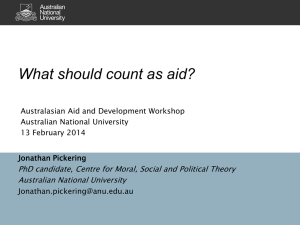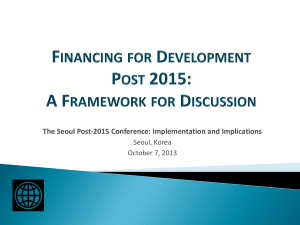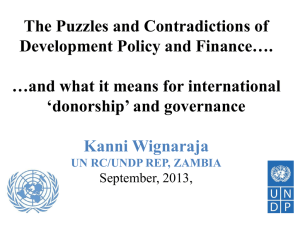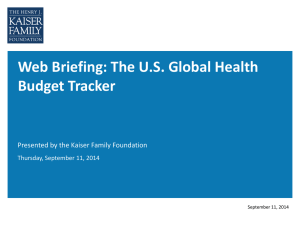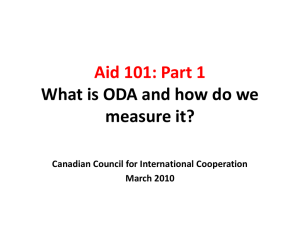Methodology to assess volumes and patterns of official development
advertisement
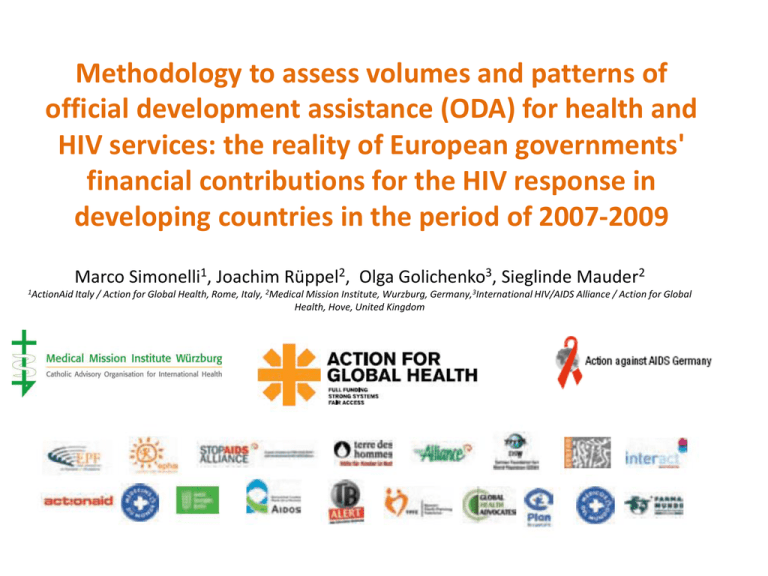
Methodology to assess volumes and patterns of official development assistance (ODA) for health and HIV services: the reality of European governments' financial contributions for the HIV response in developing countries in the period of 2007-2009 Marco Simonelli1, Joachim Rüppel2, Olga Golichenko3, Sieglinde Mauder2 1ActionAid Italy / Action for Global Health, Rome, Italy, 2Medical Mission Institute, Wurzburg, Germany,3International HIV/AIDS Alliance / Action for Global Health, Hove, United Kingdom ODA Definition and Criteria Official Development Assistance (ODA) is defined as those flows to developing countries and multilateral institutions provided by official agencies, including state and local governments, or by their executive agencies, each transaction of which meets the following tests: • it is administered with the promotion of the economic development and welfare of developing countries as its main objective; • it is concessional in character and conveys a grant element of at least 25 per cent. Source: OECD-DAC 2 Aid Activities Aid activities include: • projects and programmes • cash transfers • deliveries of goods • training courses • research projects • debt relief operations • contributions to non-governmental organizations. 3 Necessary Dimensions of ODA Analysis This research attempts to analyse the volume of the Official Development Assistance (ODA) on the part of the 17 European countries belonging to the DAC (Development Assistance Committee / OECD) on the following levels: • Total volume of resources differentiating between official figures and real resource transfers • ODA contributions for health promotion, and finally • ODA contributions for specific interventions to confront HIV A comprehensive and objective assessment of donor contributions for the response to the epidemic cannot focus solely on the aid for specific programmes of HIV prevention, treatment and support Considering all Relevant Funding Channels or Mechanisms • Bilateral flows (provided directly by a donor country to an aid recipient country) • Multilateral flows (channelled via an international organization active in development e.g. World Bank, UN Organizations, Global Fund, etc.) • Funding channelled via the European Commission represents a special case, but is subsumed by DAC/OECD as multilateral 5 Multilateral Health Financing Organizations • • • • • • • • • • • • • IDA/World Bank World Health Organization UNAIDS (Unified Budget and Work Plan) UNDP (United Nations Development Programme) UNFPA (United Nations Population Fund) UNICEF (United Nations Children's Fund) Global Fund to Fight AIDS, Tuberculosis and Malaria UNITAID GAVI Alliance International Finance Facility for Immunisation (IFFIm) Advance Market Commitments (AMC) African Development Fund Asian Development Fund Multilateral Health Financing Organizations, continued • • • • • • • • • Drugs for Neglected Diseases initiative (DNDi) Medicines for Malaria Venture (MMV) Global TB Alliance International Partnership for Microbicides (IPM) International Initiative for AIDS Vaccine (IAVI) World Food Program (WFP) International Committee of the Red Cross International Planned Parenthood Federation (IPPF) Other… Classification of Projects according to Needs Assessments developed by Millennium Project (Health Sector) and UNAIDS (HIV Response) Health funding needs include: • the cost of running a health system offering essential medical interventions, such as emergency obstetric care, treatment for the major infectious diseases, and interventions to reduce child mortality. • interventions primarily provided outside the health system, such as preventing major diseases and mitigating the social impact 8 Relevant Information Sources Source Purposes and Contents CRS Aid Activity database of DAC/OECD Basic data on (sub-)sectors, recipients, policy issues and financial volumes on a disaggregated level, i.e. for individual activities, for bilateral and most multilateral organizations DAC Statistics database Comprehensive data on the volume, origin and types of aid and resource flows on an aggregated level World Bank Project Database Data on recipients, sources, amounts of commitments and financial share of up to 5 sectors, as well as other aspects Global Fund Pledges and Contributions Tables Pledges made and contributions paid and unpaid for Global Fund Annual Reports of International Organizations Contributions paid to UN organizations, UNITAID, GAVI, etc. by donor; in some cases breakdowns by sector or theme World Health Assembly Documentation Status of collection of annual regular budget assessed contributions National Health Accounts (NHA) General government expenditure on health as % of total government expenditure 9 Methodological Features • The project-level information system of DAC/OECD constitutes the most important basis for the analysis • Examination of every single aid activity reported in the health and population sectors in order to determine the main purposes (linking activities over the years) • Insufficient or contradictory data are complemented through web-based research and direct communication with implementing agencies • Health-relevant projects recorded in other sectors are identified via text search and scrutinized accordingly Result: consolidated and structured list of pertinent projects correcting for misclassifications, reporting errors and double counting Examples of Reporting Problems Other flows recorded as Health Projects: Annual Action Programme for the Thematic Programme on Cooperation in the Area of Migration and Asylum for 2009, Commitment: 60.3 million US$ Population Census support initiative, Disbursement in 2009: 1 million US$ Recherche et analyse démographique Total Disbursements in 2009: 7 million US$ Programa de Apoyo a la Política Nacional de Seguridad Alimentaria Nutricional (Food Security) Disbursement in 2009: 12.5 million US$ Examples of Reporting Problems Other flows recorded as HIV control: Total commitment of 30 million Euros: 24 million sector budget support, 3 million for technical assistance to the Ministry of Health, and 3 million to help the National AIDS Council (imputed HIV support: 5.7 million Euros or 19%) Co-Financing Health Sector Budget Support Disbursement in 2009: 8.4 million US$ General medical and laboratory equipment, laboratory infrastructure and laboratory design components Disbursements in 2009: 24.8 million US$ Examples of Reporting Problems Core contributions to international organizations recorded as bilateral aid (potential double counting): France for UNITAID Disbursements in 2008: 207.7 million US$ Germany for UNAIDS Disbursement in 2009: 4.9 million US$ United Kingdom for International Partnership on Microbicides Disbursement in 2009: 9.8 million US$ Examples of Reporting Problems HIV Components not recorded as HIV control: European and Developing Countries Clinical Trials Partnership (EDCTP), to help facilitate and develop clinical trials for new drugs and vaccines against HIV/AIDS, malaria and TB Total disbursement in 2007: 53.6 million US$, imputable HIV contribution: 32.2 million US$ Higher Education HIV & AIDS (HEAIDS) Disbursement in 2007: 0.7 million US$ Emergency Food Aid for HIV/AIDS-patients Disbursements in 2009: 1 million US$ General ODA • OECD-accepted ODA includes expenditure items and accounting entries that do not represent real transfers of financial, technical or personnel resources, namely debt relief, imputed student costs, administrative costs and expenditure for refugees in donor countries • Some European DAC countries provide a considerable part of their ODA in the form of loans, a practice that contravenes the orientation towards needs. • Real ODA Grant Transfers after deducting these questionable items show great differences and are in many cases significantly lower than official figures Euro Million 12,000 Evolution of France's ODA 2004-2010: 11,000 Composition of Gross Disbursements 10,000 and Repayments from Recipients 9,000 Administrative Costs 1,859 Refugees in donor countries Imputed student costs 1,009 8,000 2,789 7,000 1,412 5,000 496 1,799 188 764 733 2,176 2,232 151 88 658 4,000 3,000 675 1,094 2,706 6,000 1,873 1,329 Debt Relief 1,722 2,206 666 651 3,421 3,344 2,147 1,758 159 207 2,322 2,211 -860 -979 2004 2005 Bilateral Loans Bilateral Grants (real Transfers) Multilateral Loans Multilateral Grants 2,000 1,000 1,290 2,544 2,691 3,060 Repayments (negative amount) 0 -1,000 -2,000 -1,525 2006 -1,034 -993 -900 -847 2007 2008 2009 2010 Data for multilateral loans in 2010 are not available yet and were calculated on the basis of the proportions of loans in the previous year Evolution of France's ODA in relation to Gross national Income: 0.70% 0.60% Collective Intermediate Target of EU: 0.56% of GNI Minimum Target of EU: 0.51% of GNI 0.50% 0.47% 0.47% 0.41% 0.47% 0.38% 0.40% 0.39% 0.29% 0.30% 0.24% 0.23% 0.23% 0.20% 0.20% 0.18% 0.18% 2005 2006 0.50% 0.35% 0.37% DAC standard Real Transfers 0.25% Grants only 0.20% 0.21% 0.22% 2007 2008 2009 0.24% 0.10% 0.00% 2004 ODA ratios according to different modes of calculation 2010 Euro Million 12,000 Evolution of Germany's ODA 2004-2010: 11,000 Composition of Gross Disbursements 10,000 9,000 1,778 8,000 2,066 2,121 7,000 2,802 6,000 397 4,000 and Repayments from Recipients 1,914 Administrative Costs 1,158 Refugees in donor countries Imputed student costs 1,145 917 854 3,826 583 5,000 61 125 4,071 3,351 573 Bilateral Loans 2,849 2,769 2,190 Bilateral Grants (real Transfers) Multilateral Loans 2,536 3,000 2,000 2,994 2,120 1,000 2,709 3,171 3,410 3,578 3,556 Multilateral Grants Repayments (negative amount) 0 -934 -843 -1,053 -927 -890 -868 -1,011 2004 2005 2006 2007 2008 2009 2010 -1,000 -2,000 Debt Relief Evolution of Germany's ODA in relation to Gross National Income: 0.70% 0.60% Collective Intermediate Target of EU: 0.56% of GNI Minimum Target of EU: 0.51% of GNI 0.50% 0.40% 0.30% 0.36% 0.36% 0.37% 0.20% 0.19% 0.35% 0.28% 0.28% 0.22% 0.38% 0.23% 0.19% 0.38% DAC standard 0.34% 0.21% 0.27% 0.26% 2009 2010 0.23% 0.10% 0.00% 2004 2005 2006 Real Transfers 0.25% 0.19% 0.17% 0.31% ODA ratios according to different modes of calculation 2007 2008 Grants only 0.70% 0.60% 0.56% Collective Intermediate Target of EU: 0.56% of GNI Minimum Target: 0.51% of GNI 0.50% 0.51% 0.51% 0.47% 0.43% 0.40% 0.30% 0.36% 0.35% 0.30% 0.30% 0.28% 0.29% 2004 2005 0.33% 0.36% 0.33% 0.39% Evolution of United Kongdom's ODA in relation to Gross National Income: 0.54% ODA ratios 0.51% according to different modes of calculation 0.49% 0.46% DAC standard 0.36% Real Transfers 0.30% Grants only 0.20% 0.10% 0.00% 2006 2007 2008 2009 2010 as a % of GNI 0.70% 0.60% Collective Intermediate Target of EU: 0.56% of GNI 0.50% 0.45% 0.44% 0.44% 0.41% 0.40% 0.30% Evolution of European DAC member's ODA in relation to Gross National Income: 0.46% 0.40% 0.36% 0.30% 0.31% 0.28% 0.28% 2005 2006 0.33% 0.33% 0.36% 0.48% ODA ratios according to different 0.41% DAC standard 0.36% Real Transfers 0.30% Grants only 0.20% 0.10% 0.00% 2007 2008 2009 2010 100.0% Share of European DAC member's ODA in relation to all DAC Members 90.0% 80.0% 70.0% DAC standard 60.0% Real Transfers 50.0% Grants only 40.0% GNI 30.0% 20.0% 10.0% 0.0% 2005 2006 2007 2008 2009 2010 Official Development Assistance of European DAC Member Countries: Real ODA Transfers and Grants in relation to Gross National Income (GNI) 1.04% Luxembourg 1.04% 0.94% Norway 0.92% 0.85% Sweden 0.85% 0.81% Denmark 0.80% 0.67% Netherlands 0.67% United Kingdom 0.51% 0.50% Ireland 0.50% 0.49% 0.47% Belgium 0.46% Grants only 0.34% Switzerland 0.33% Spain 0.30% Germany 0.26% France 0.24% 0.38% 0.34% 0.36% Minimum Ratio of EU for 2010: 0.51% 0.24% Austria 0.24% 0.17% 0.27% 0.14% Italy 0.13% Greece 0.13% 0.00% Real Transfers 0.50% Finland Portugal 0.54% UN Target since 1970: 0.7% 0.13% 0.10% 0.20% 0.30% 0.40% 0.50% 0.60% 0.70% 0.80% 0.90% 1.00% 1.10% ODA for Health • Only four out of 17 countries (Luxemburg, Norway, Sweden and Ireland) reached in 2009 the target level of 0.1% recommended by the Commission on Macroeconomics and Health • Only the first three countries achieved the target of 0.12% of GNI based on the assumption that European DAC countries cover at least 50% of financing needs • The main part of the European gap results from the fact that most of the larger economies (Germany, France, Italy, Spain) fall far short of the targets • The extremely low contributions from some medium-sized economies (Austria, Switzerland) also have a considerable negative impact Germany's Bilateral ODA Contributions for Health Promotion and the Response to the HIV Epidemic (US$ millions) Commitments Contributions for Health Category of Aid Activity 2007 2008 2009 Contributions for HIV Response Share in % 2007 2008 2009 Recorded in Health Sectors Recorded in Other Sectors Total Contributions Total Contributions 2007 2008 2009 2007 2008 2009 Specific HIV Interventions 59.2 110.0 115.5 100% 59.2 110.0 115.5 57.6 104.6 112.5 1.6 5.4 2.9 Projects of Reproductive Health 15.9 31.6 65.1 25% 4.0 7.9 16.3 15.9 31.4 58.1 0.0 0.1 7.0 167.8 227.3 221.3 10% 16.8 22.7 22.1 166.9 215.5 218.0 0.9 11.8 3.2 0.0 0.6 3.5 10% 0.0 0.1 0.3 0.0 0.6 3.4 0.0 0.0 0.1 Immunisation 83.8 66.2 73.9 0% 0.0 0.0 0.0 83.8 66.2 73.9 0.0 0.0 0.0 Other Health Problems 24.4 35.5 40.6 0% 0.0 0.0 0.0 23.8 35.4 40.6 0.6 0.1 0.0 351.1 471.2 519.9 79.9 140.7 154.2 348.1 453.7 506.6 3.1 17.5 13.2 10.8 20.1 19.4 1.1 2.0 1.9 361.9 491.3 539.2 XXX 81.0 142.7 156.2 0.0 0.0 0.0 XXX na na na 22.6 22.4 7.4 XXX na na na 9.4 3.8 4.2 XXX na na na 6.8% 6.2% 6.8% XXX Health Sector Programmes Child health ODA for Specific Health Projects General Budget Support Total Bilateral ODA for Health Memo: Emergency Projects Memo: Multilateral shown separately Memo: Other Sectors recorded as Health Share of Bilateral Real ODA XXX 10% 1.5% 1.8% 2.0% Germany's Bilateral ODA Contributions for Health Promotion and the Response to the HIV Epidemic (US$ millions) Disbursements Contributions for Health Category of Aid Activity 2007 2008 2009 Contributions for HIV Response Share in % 2007 2008 2009 Recorded in Health Sectors Recorded in Other Sectors Total Contributions Total Contributions 2007 2008 2009 2007 2008 2009 Specific HIV Interventions 75.0 85.2 91.4 100% 75.0 85.2 91.4 73.0 82.3 88.3 2.0 2.8 3.1 Projects of Reproductive Health 40.0 30.1 36.6 25% 10.0 7.5 9.2 38.2 28.2 34.5 1.8 1.9 2.2 141.6 188.9 218.1 10% 14.2 18.9 21.8 140.3 177.1 212.2 1.2 11.8 5.9 0.5 2.0 4.2 10% 0.0 0.2 0.4 0.5 2.0 4.2 0.0 0.0 0.0 Immunisation 40.5 65.4 27.1 0% 0.0 0.0 0.0 40.5 65.4 27.1 0.0 0.0 0.0 Other Health Problems 25.7 29.6 30.0 0% 0.0 0.0 0.0 25.7 29.5 30.0 0.0 0.1 0.0 323.2 401.1 407.3 99.2 111.8 122.8 318.1 384.5 396.1 5.1 16.7 11.2 10.5 7.8 19.6 1.0 0.8 2.0 Gross Bilateral ODA for Health, total 333.7 408.9 426.8 XXX 100.2 112.6 124.7 Imputable Repayments -37.5 -38.2 -36.5 XXX -0.1 -0.1 -0.1 Net Bilateral ODA for Health, total 296.2 370.7 390.4 XXX 100.1 112.5 124.6 0.0 0.0 0.0 XXX na na na 25.7 13.2 14.3 XXX na na na 6.3 7.9 14.3 XXX na na na 7.8% 7.3% 7.0% XXX Health Sector Programmes Child health ODA for Specific Health Projects General Budget Support Memo: Emergency Projects Memo: Multilateral shown separately Memo: Other Sectors recorded as Health Share of Bilateral Real ODA XXX 10% 2.6% 2.2% 2.2% Germany's ODA Disbursements for Health Promotion and HIV Response through multilateral Organizations and Total Estimate ODA Contributions for Health Pomotion Total ODA Contributions Financing Mechanism 2007 2008 2009 2010 2007 2008 2009 ODA Contributions for HIV Response 2010 2007 2008 2009 2010 Share of Health Pomotion 2007 2,452.3 2,812.6 2,891.0 2,926.0 200.1 224.1 199.2 201.6 60.8 56.3 41.6 42.1 IDA / World Bank 1,097.1 1,135.8 1,029.7 691.92 116.0 118.2 95.3 56.9 36.5 37.8 23.5 17.7 10.6% 10.4% 29.4 30.9 31.1 30.2 29.4 30.9 31.1 30.2 2.7 2.9 3.0 2.9 100.0% 100.0% 1.6 2.7 5.1 3.6 1.6 2.7 5.1 3.6 1.6 2.7 5.1 3.6 100.0% 100.0% UNDP 47.0 40.7 38.4 29.5 1.7 1.4 1.5 1.2 1.6 1.2 1.5 1.1 3.7% UNFPA 25.7 26.0 25.1 19.5 21.5 21.4 18.0 14.0 7.5 8.4 7.7 6.0 UNICEF 6.1 8.3 9.1 8.2 1.2 1.5 2.1 1.9 0.4 0.5 0.5 0.5 116.7 312.2 271.4 265.8 116.7 312.2 271.4 265.8 74.3 192.9 127.5 UNITAID 0.0 0.0 0.0 0.0 0.0 0.0 0.0 0.0 0.0 0.0 GAVI 5.9 0.0 5.7 5.1 5.9 0.0 5.7 5.1 0.1 0.0 IFFIm 0.0 0.0 0.0 0.0 0.0 0.0 0.0 0.0 AMC 0.0 0.0 0.0 0.0 0.0 0.0 0.0 AfDF 125.7 213.3 217.3 222.3 13.0 18.4 11.6 AsDF 50.6 53.3 52.5 53.7 0.8 0.9 1.1 WFP 65.8 100.7 132.1 168.0 1.4 2.4 DNDi 0.0 0.5 1.0 0.0 0.0 MMV 0.0 0.0 0.0 0.0 WHO core UNAIDS Global Fund Global TB Alliance IPM 8.0% 2009 6.9% 2010 2007 2008 2009 2010 6.9% 2.5% 2.0% 1.4% 1.4% 9.3% 8.2% 3.3% 3.3% 2.3% 2.6% 100.0% 100.0% 9.1% 9.5% 9.5% 9.5% 100.0% 100.0% 100.0% 100.0% 100.0% 100.0% 3.3% 4.0% 4.0% 3.5% 3.0% 3.8% 3.8% 83.7% 82.3% 71.7% 71.7% 29.2% 32.3% 30.5% 30.5% 19.4% 17.7% 23.3% 23.3% 6.9% 5.4% 6.0% 6.0% 124.8 100.0% 100.0% 100.0% 100.0% 63.7% 61.8% 47.0% 47.0% 0.0 0.0 100.0% 100.0% 100.0% 100.0% 49.3% 49.3% 49.3% 49.3% 0.1 0.1 100.0% 100.0% 100.0% 100.0% 2.5% 2.7% 1.3% 1.3% 0.0 0.0 0.0 100.0% 100.0% 100.0% 100.0% 2.5% 2.7% 1.3% 1.3% 0.0 0.0 0.0 0.0 100.0% 100.0% 100.0% 100.0% 2.5% 2.7% 1.3% 1.3% 11.8 1.9 3.4 1.7 1.7 10.4% 8.6% 5.3% 5.3% 1.5% 1.6% 0.8% 0.8% 1.1 0.1 0.1 0.1 0.1 1.5% 1.6% 2.1% 2.1% 0.2% 0.2% 0.2% 0.2% 3.4 4.3 1.4 2.4 3.4 4.3 2.1% 2.4% 2.6% 2.6% 2.1% 2.4% 2.6% 2.6% 0.5 1.0 0.0 0.0 0.0 0.0 0.0 100.0% 100.0% 100.0% 100.0% 0.0% 0.0% 0.0% 0.0% 0.0 0.0 0.0 0.0 0.0 0.0 0.0 100.0% 100.0% 100.0% 100.0% 0.0% 0.0% 0.0% 0.0% 0.0 0.0 0.0 0.0 0.0 0.0 0.0 0.0 100.0% 100.0% 100.0% 100.0% 0.0% 0.0% 0.0% 0.0% 1.4 1.4 1.4 0.0 1.4 1.4 1.4 0.0 100.0% 100.0% 100.0% 100.0% 100.0% 100.0% 100.0% 100.0% 100.0% 1.4 1.4 0.0 0.0 0.0 0.0 0.0 0.0 0.0 0.0 0.0 100.0% 100.0% 100.0% 100.0% 100.0% 100.0% 100.0% ICRC 19.8 30.7 28.4 28.6 1.5 2.9 3.6 3.6 0.2 0.3 0.4 0.4 7.8% 9.5% 12.7% 12.7% 0.8% 0.9% 1.3% 1.3% IPPF 4.9 5.2 8.3 5.9 4.9 5.2 8.3 5.9 1.2 1.3 2.1 1.5 100.0% 100.0% 100.0% 100.0% 25.0% 25.0% 25.0% 25.0% FIND na 0.0 0.0% IAVI 1.4 8.2% 2008 Europ. Union Share of HIV Response 0.0 0.0 IUATLD Other: BACKUP-Initiative (Global Fund) na 0.0 0.0 0.0 na 0.0 0.0 0.0 100.0% 100.0% 100.0% 100.0% 0.0% 0.0% 0.0% 0.0 0.0 0.0 0.0 0.0 0.0 0.0 0.0 100.0% 100.0% 100.0% 100.0% 0.0% 0.0% 0.0% 0.0% 100.0% 100.0% 100.0% 100.0% 63.7% 61.8% 47.0% 47.0% 13.1 5.0 8.0 8.0 13.1 5.0 8.0 8.0 8.3 3.1 3.8 3.8 Total Multilateral (relevant Org.) 4,063.1 4,779.3 4,755.5 4,466.2 530.2 749.0 667.8 615.1 200.1 314.7 223.1 210.4 Bilateral Health Projects na na na na 125.0 323.2 401.1 407.3 447.4 99.2 111.8 122.8 72.9 56.5 136.1 136.1 10.5 7.8 19.6 16.8 1.0 0.8 2.0 1.7 -1,230.3 -1,255.0 -1,196.6 -1,422.2 -37.5 -38.2 -36.5 -43.3 -0.1 -0.1 -0.1 -0.1 126.5 General Budget Support Imputable repayments Net Bilateral Real Transfers total 3,794.3 5,086.4 5,585.5 6,587.8 296.2 370.7 390.4 420.8 100.1 112.5 124.6 Net ODA (Real Transfers), total 8,226.7 10,118.6 10,714.5 11,297.3 826.4 1,119.7 1,058.2 1,035.9 300.2 427.1 347.7 337.0 0.25% 0.28% 0.31% 0.34% 0.025% 0.031% 0.031% 0.031% 0.009% 0.012% 0.010% 0.010% 9.9% 9.2% 3.6% 4.2% 3.2% 3.0% Total Contributions as a % of GNI Share of Total Real ODA Transfers na Net ODA (Real Transfers), total, Euro 6,009.6 7,015.2 7,694.1 8,529.9 603.7 776.3 759.9 782.1 219.3 296.1 249.7 254.4 1.53 1.86 1.95 2.03 0.15 0.21 0.19 0.19 0.06 0.08 0.06 0.06 Net ODA per cap. of devel. regions US$ na na na 10.0% 11.1% Official Development Assistance of European DAC Member Countries: Net Disbursements for Health Promotion in relation to Gross National Income (GNI) including Loans 0.186% Luxembourg 0.149% Norway 0.132% Sweden 0.103% Ireland 0.098% Netherlands 0.078% United Kingdom 0.056% Belgium 0.050% Spain 0.031% Germany 0.028% Switzerland Greece Portugal 0.000% 2007 0.041% France Austria 2008 0.052% Finland Italy 2009 0.091% Denmark Appropriate Contribution Level for European Donors: 0.12% 0.017% 0.017% 0.014% 0.013% 0.100% 0.200% Official Development Assistance of European DAC Member Countries: Net Disbursements for Health Promotion in relation to Gross National Income (GNI) with and without Loans 0.186% Luxembourg 0.186% 0.149% Norway 0.149% 0.132% Sweden 0.132% 0.103% Ireland 0.103% 0.098% Netherlands 0.098% Grants only 0.091% Denmark 0.091% 0.078% United Kingdom 0.078% 0.056% Belgium 0.056% 0.052% Finland All Transfers 0.052% 0.048% Spain 0.050% 0.041% France 0.041% Germany 0.029% Switzerland 0.028% 0.031% Appropriate Contribution Level for European Donors: 0.12% 0.028% Austria 0.017% Italy 0.017% Greece 0.014% Portugal 0.013% 0.017% 0.017% 0.014% 0.013% 0.000% 0.100% 0.200% Volumes and Composition of European's DAC Members ODA for Health in 2009 US$ million Ranked by GNI, Lending includes ODA Loans and Equity Investments 2,000 1,800 Bilateral Lending 1,600 1,400 1,200 Bilateral Grants Multilateral Grants 1,000 Imputable Repayments 800 600 400 200 0 -200 ODA Transfers and Grants of European's DAC Members for Health in 2009 US$ million Ranked by GNI, Lending includes ODA Loans and Equity Investments 4,500 4,000 3,500 3,000 2,500 2,000 1,500 1,000 500 0 Target Volume 0.12% of GNI Target Volume 0.1% of GNI Net ODA Transfers for Health Net ODA Grants for Health ODA for HIV Response • The analysis was completed for 11 countries with higher GNI representing 92% of total GNI of European DAC members • We observe abysmal differences regarding financial efforts: Whereas few countries contributed their fair share others paid less than a tenth of what they should pay • Again, the backlog of the majority of larger economies (Germany, France, Spain and especially Italy) is responsible for the main part of the gap • The effect of the correction through project-by-project review is even larger than in the case of ODA for health Official Development Assistance of European DAC Member Countries: Net Disbursements for the HIV Response in relation to Gross National Income (GNI) 0.057% Sweden 0.046% Norway 0.039% Netherlands 0.024% United Kingdom 0.015% Spain 2008 0.015% Belgium 0.014% France 2007 0.010% Germany 0.007% Switzerland Appropriate Contribution Level for European Donors: 0,05% 0.004% Austria Italy 2009 0.003% 0.000% 0.010% 0.020% 0.030% 0.040% 0.050% 0.060% 0.070% 0.080% 0.090% 0.100% Geographic Distribution • Analysis of Health ODA per capita made available by 5 larger economies and the European Union casts doubt on coordination and orientation towards countries with highest needs • Final appraisal will take into account ODA for Health promotion and HIV response by all donors Share of Sub-Saharan Africa in ODA for Health and for HIV Response by European Donors 100.0% ODA for HIV Response ODA for Health 90.0% 80.0% 70.0% 60.0% 50.0% 40.0% 30.0% 20.0% 10.0% France Germany Italy Spain United Kingdom European Union 0.0% 2007 2008 2009 2007 2008 2009 12.00 10.00 9.00 7.00 6.00 4.00 Equatorial Guinea Djibouti Grenada Moldova Zimbabwe Palestinian Adm. Areas Sierra Leone Malawi Zambia Liberia Mozambique Rwanda Comoros Namibia Serbia St. Lucia Guinea-Bissau Mauritania Libya Cape Verde Cambodia Sao Tome & Principe Burkina Faso Senegal Nicaragua Guyana Kyrgyz Rep. Burundi Morocco Ghana Benin Kenya Peru Gabon Tanzania Afghanistan Central African Rep. Barbados Togo Albania Niger Angola Suriname Congo, Dem. Rep. Mali Lebanon Swaziland Lesotho South Africa Bolivia Nepal El Salvador Syria Paraguay Uganda Montenegro Tajikistan Georgia Jamaica Cameroon Dominican Republic Chad Nigeria Timor-Leste Somalia Ethiopia Guinea Argentina Myanmar Laos Bosnia and Herzegovina Guatemala Haiti Armenia Ecuador Gambia Viet Nam Congo, Rep. Tunisia Trinidad & Tobago Bhutan Côte d'Ivoire Mongolia Jordan Yemen Bangladesh Honduras Philippines Sudan Uruguay India Papua New Guinea Macedonia, FYR Cuba Uzbekistan Iraq Azerbaijan Egypt Panama Ukraine Indonesia Botswana Madagascar Pakistan Kazakhstan Kosovo Venezuela Eritrea Thailand Sri Lanka China Colombia Chile Belarus Fiji Costa Rica Korea, Dem. Rep. Mexico Brazil Croatia Algeria Solomon Islands Turkey US$ ODA for Health from Five European DAC Members per Capita in 2009, all Recipients 14.00 13.00 European Union 11.00 United Kingdom Spain 8.00 Italy 5.00 Germany France 3.00 2.00 1.00 0.00 12.00 10.00 9.00 7.00 6.00 4.00 Equatorial Guinea Djibouti Grenada Moldova Zimbabwe Palestinian Adm. Areas Sierra Leone Malawi Zambia Liberia Mozambique Rwanda Comoros Namibia Serbia St. Lucia Guinea-Bissau Mauritania Libya Cape Verde Cambodia Sao Tome & Principe Burkina Faso Senegal Nicaragua Guyana Kyrgyz Rep. Burundi Morocco Ghana Benin Kenya Peru Gabon Tanzania Afghanistan Central African Rep. Barbados Togo Albania Niger Angola Suriname Congo, Dem. Rep. Mali Lebanon Swaziland Lesotho South Africa Bolivia Nepal El Salvador Syria Paraguay Uganda Montenegro Tajikistan Georgia Jamaica Cameroon Dominican Republic Chad US$ ODA for Health from Five European DAC Members per Capita in 2009, Recipients > 1€ 14.00 13.00 European Union 11.00 United Kingdom Spain 8.00 Italy 5.00 Germany France 3.00 2.00 1.00 0.00 Eritrea Madagascar Botswana Sudan Côte d'Ivoire Congo, Rep. Gambia Guinea 4.00 Ethiopia 6.00 Nigeria 7.00 Somalia 9.00 Chad 10.00 Cameroon 11.00 Uganda 12.00 South Africa Lesotho Swaziland Mali Congo, Dem. Rep. Angola Niger Togo Central African Rep. Tanzania Gabon Kenya Benin Ghana Burundi Senegal Burkina Faso Sao Tome & Principe Cape Verde Mauritania Guinea-Bissau Namibia Comoros Rwanda Mozambique Liberia Zambia Malawi Sierra Leone 14.00 Mauritius Zimbabwe Djibouti Equatorial Guinea US$ ODA for Health from Five European DAC Members per Capita in 2009, Sub-Saharan Africa 13.00 European Union United Kingdom Spain 8.00 Italy Germany 5.00 France 3.00 2.00 1.00 0.00 Next steps • Action for Global Health plans to develop partnerships with local organisations from civil society in order to track the internal ODA flows in a sample of African countries including the allocation by sub-regions, delivery channels, target populations and programmatic orientations. This in-depth analysis will consider the interplay with other funding sources, mainly the resources raised domestically by the general government and households. Thereby we expect to produce reliable results and to contribute, simultaneously, to strengthening the capacity of democratic control in the field of development and health financing More information see: www.actionforglobalhealth.eu www.medmissio.de

